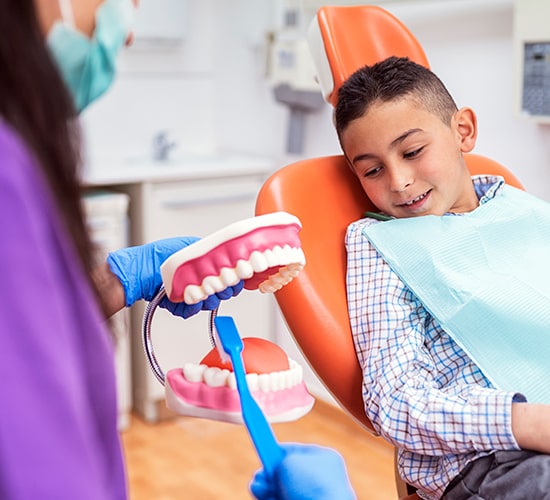
- Call Today (703) 378-2000
- Open Hour 09:00 AM to 5:00 PM


Good oral hygiene removes bacteria and the left-over food particles that combine to create cavities. For infants, use a soft toothbrush, wet gauze or a clean washcloth to wipe the plaque from teeth and gums. Avoid putting your child to bed with a bottle filled with anything other than water.
For older children, brush their teeth at least twice a day. Also, watch the number of snacks containing sugar that you give your children.
The American Academy of Pediatric Dentistry recommends visits every six months to the pediatric dentist, beginning at your child's first birthday. Routine visits will start your child on a lifetime of good dental health.
Your pediatric dentist may also recommend protective sealants or home fluoride treatments for your child. Sealants can be applied to your child's molars to prevent decay on hard to clean surfaces.
You can make the first visit to the dentist enjoyable and positive. If old enough, your child should be informed of the visit and told that the dentist and their staff will explain all procedures and answer any questions.
It is best if you refrain from using words around your child that might cause unnecessary fear, such as needle, pull, drill or hurt. Pediatric dentists use words that convey the same message but are pleasant and non-frightening to the child.
Brushing Tips:
Flossing Tips:
Good Diet = Healthy Teeth:
Healthy eating habits lead to healthy teeth. Like the rest of the body, the teeth, bones and the soft tissues of the mouth need a well-balanced diet. Children should eat a variety of foods from the five major food groups. Most snacks that children eat can lead to cavity formation. The more frequently a child snacks, the greater the chance for tooth decay. How long food remains in the mouth also plays a role. For example, hard candy and breath mints stay in the mouth a long time, which cause longer acid attacks on tooth enamel. If your child must snack, choose nutritious foods such as vegetables, low-fat yogurt, and low-fat cheese, which are healthier and better for children's teeth.
Fluoride:
Fluoride has been shown to prevent cavities in both children and adults. Fluoride can be found in fluoridated water, toothpaste and mouth rinse. In children, fluoride can help strengthen both the teeth they already have and the teeth that are still developing under the gums.
At-Home Fluoride Use:
According to the American Academy of Pediatric Dentistry fluoride toothpaste is recommended to reduce cavities in children. Children less than 3 years old should use no more than a smear or rice-size amount of fluoride toothpaste. Children age 3-6 years old should use no more than a pea-size of fluoride toothpaste. Fluoride mouth rinse is recommended for children the age of 6 or older who can spit and who are at high risk for dental cavities.
In-Office Topical Fluoride Varnish:
Fluoride varnish is a treatment that is offered at our office during a child’s dental check-up. The fluoride varnish is painted on the teeth after the child’s teeth are cleaned. Fluoride varnish has a higher concentration of fluoride than is found in toothpaste.
Xylitol (Fluoride Alternative):
The American Academy of Pediatric Dentistry (AAPD) recognizes the benefits of xylitol on the oral health of infants, children, adolescents, and persons with special health care needs.
The use of XYLITOL GUM by mothers (2-3 times per day) starting 3 months after delivery and until the child was 2 years old, has proven to reduce cavities up to 70% by the time the child was 5 years old.
Studies using xylitol as either a sugar substitute or a small dietary addition have demonstrated a dramatic reduction in new tooth decay, along with some reversal of existing dental cavity. Xylitol provides additional protection that enhances all existing prevention methods. This xylitol effect is long-lasting and possibly permanent. Low decay rates persist even years after the trials have been completed.
Xylitol is widely distributed throughout nature in small amounts. Some of the best sources are fruits, berries, mushrooms, lettuce, hardwoods, and corn.
Studies suggest xylitol intake that consistently produce positive results ranged from 4-20 grams per day, divided into 3-7 consumption periods. Consumption frequency of less than 3 times per day showed no effect.
To find gum or other products containing xylitol, try visiting your local health food store or search the Internet to find products containing 100% xylitol.
Sealants:
A sealant is a protective coating that covers the deep pits and grooves on the chewing surfaces of the tooth. This helps to prevent food particles from getting caught in the pits and grooves, which can cause cavities.
Mouth Guards:
Mouth guards are an important piece of athletic equipment that can help protect children’s teeth and jaws. Our office offers custom-made mouth guards that are properly fitted which makes them more comfortable to wear. We recommend children wear a mouth guard for any sport that could result in trauma to the mouth or face.
Copyright © 2026 Chantilly Pediatric Dentistry | Dr. Fernanda G. Fontes is proudly created by DC Social Marketing